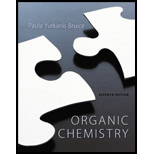
(a)
Interpretation:
Mechanism for the given reaction should be proposed.
Concept Introduction:
Unimolecular nucleophilic substitution reaction in which the reversible ionization of
If the leaving group in
An enantiomer, also known as an optical isomer, is one of two stereoisomers that are mirror images of each other that are non-superimposable.
(b)
Interpretation:
The formation of two products in the given reaction should be explained.
Concept Introduction:
Unimolecular nucleophilic substitution reaction in which the reversible ionization of alkyl halide in the presence of aqueous acetone or an aqueous ethyl alcohol provides a carbocation as an intermediate, attacked by the nucleophile to form the product.
If the leaving group in
An enantiomer, also known as an optical isomer, is one of two stereoisomers that are mirror images of each other that are non-superimposable.
(c)
Interpretation:
Reason for the single substation products obtained in the given reaction should be explained.
Concept Introduction:
Unimolecular nucleophilic substitution reaction in which the reversible ionization of alkyl halide in the presence of solvent provides a carbocation as an intermediate, attacked by the nucleophile to form the product.
If the leaving group in
An enantiomer, also known as an optical isomer, is one of two stereoisomers that are mirror images of each other that are non-superimposable.
Want to see the full answer?
Check out a sample textbook solution
Chapter 9 Solutions
Organic Chemistry; Modified MasteringChemistry with Pearson eText -- ValuePack Access Card; Study Guide and Student Solutions Manual for Organic Chemistry, Books a la Carte Edition (7th Edition)
- Draw product A. Select Draw Rings More Erase | / | | H CI N S Reaction A. NH2arrow_forwardFor each reaction, write the letter corresponding to the type of reaction (before the number) and draw the MAJOR product (in the product side). A. Nucleophilic Addition B. Nucleophilic Condensation C. Nucleophilic Acyl Substitutionarrow_forwardCHOOSE THE LETTER OF THE CORRECT ANSWER. 1. An aldehyde commonly exhibits a nucleophilic addition type of reaction. When a nucleophile attacks a carbonyl carbon, what happens to the oxygen atom in the structure? Refer to the structure below. a. Oxygen atom obtains a net negative charge. b. Oxygen atom acts as the new electrophile. c. Oxygen atom becomes more electronegative. d. Oxygen atom transforms to an alkoxide group.arrow_forward
- draw the reaction, including reactants, reagents and products.arrow_forwardGl A. intermediate. alkyl halide is most likely to undergo the reaction mechanism which forms a carbocationarrow_forwardExplain why using one or two equivalents of NaH results in different products in the following reactions.arrow_forward
- please help with this question. thank you. identify the starting material to make each acetal.arrow_forwardIdentify the reactions A and B.arrow_forwardNBS is used in the bromination of allylic carbons to provide a high concentration of bromine needed for the reaction. a low concentration of bromine needed for the reaction. a high concentration of HBr needed for the reaction. a low concentration of HBr needed for the reaction. B and Darrow_forward
- Synthesize each compound from acetylene. You may use any other organic or inorganic reagents. C. CH,CH,CH,CH, CHO d. CH3CH, CHỖ CHarrow_forwarda.) What is the mechanism of the reaction? b.) What is the mechanism when HCl is added to the product?arrow_forwardExplain why two substitution products are formed in the attached reaction.arrow_forward
 Organic Chemistry: A Guided InquiryChemistryISBN:9780618974122Author:Andrei StraumanisPublisher:Cengage Learning
Organic Chemistry: A Guided InquiryChemistryISBN:9780618974122Author:Andrei StraumanisPublisher:Cengage Learning
